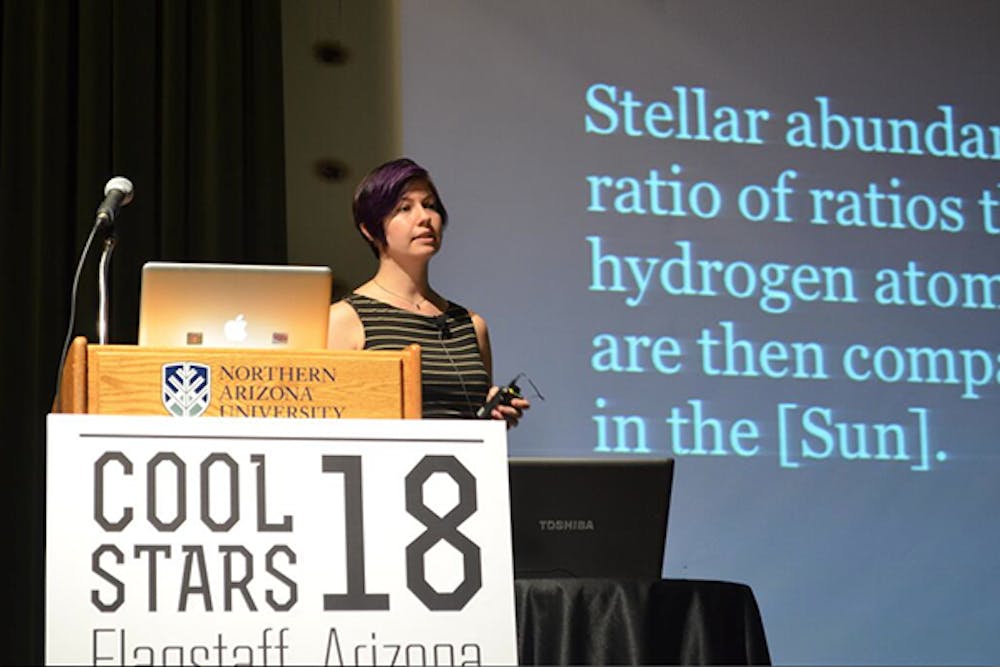 Hinkel speaking about the Hypatia Catalog at the Cool Stars 18 convention in Flagstaff in June. (Photo Courtesy of Natalie Hinkel)
Hinkel speaking about the Hypatia Catalog at the Cool Stars 18 convention in Flagstaff in June. (Photo Courtesy of Natalie Hinkel)ASU alumna Natalie Hinkel has broken new ground in the world of astronomy this month by publishing a catalog of elemental abundances in more than 3,000 stars within 500 light years of our own sun, and it may lead to interesting discoveries about the birth and life of our galaxy.
Hinkel, with the help of a handful of contributors located here at ASU and at the Global Science Institute in Wisconsin, published "The Hypatia Catalog" on Aug. 18, more than four years after the project’s genesis.
Named after one of the Roman Empire’s first known female astronomers, Hinkel said the catalog is special because of its comprehensive nature.
Hinkel said there are many catalogs that record the elemental composition of stars, but "The Hypatia Catalog" encompasses more stars than any other stellar composition catalog and more measurements for each star's elemental composition.
Whereas most star catalogs that record elemental composition list only one measurement per element for each star, Hinkel’s includes a compilation of multiple estimates based on different measurements taken by researchers around the world.
This approach ensures a greater degree of accuracy in the catalog, Hinkel said.
As researchers are not able to physically take samples from distant stars to measure their elemental make-ups, they are forced to rely on more abstract methods of measurement whose results are subject to substantial variation.
By recording a broader range of data, Hinkel said she hoped to provide a more unbiased selection of information in "The Hypatia Catalog."
ASU astronomy professor Patrick Young, who has worked extensively with Hinkel on the catalog, said this aspect of the project spawned one of its greatest challenges.
“Everybody thinks their answers are the right ones,” he said.
Because researchers collect accurate data to the best of their abilities, "The Hypatia Catalog’s" recognition of multiple measurements is often interpreted as offensive by members of the scientific community, Hinkel and Young said.
However, both said the information demonstrated by the catalog has made any hardship or discouraging feedback worthwhile.
As the opening sentence of the introduction to Hinkel’s catalog states, “One of the primary tools to understanding the history of the solar neighborhood, and more generally the Milky Way, is the chemical composition of stars.”
"The Hypatia Catalog" enabled Hinkel and her colleagues to compare the chemical composition of stars with their location, and they discovered a “layered salad” of stars within their sphere of observation that could reveal new information about the formation of the Milky Way.
Previous models of the Milky Way had depicted the galaxy as a mix of stars with chemical compositions that were evenly dispersed — what Hinkel described as a “well-mixed salad.”
The new “layered salad” model has inspired a hypothesis that the galaxy may have been formed in two separate events.
“This is at the level of speculation, but maybe there was a burst of star formation very recently in the galaxy’s history, perhaps due to an interaction with a neighboring satellite galaxy,” Young said.
This is a hypothesis that he and Hinkel plan to investigate further in the future with the help of their colleagues.
In order to analyze the reasons behind the differences in data collected by different researchers, they are also in the process of investigating the variety of methods used to determine star composition
“I’ve always been passionate about big picture astronomy,” Hinkel said.
She said working on "The Hypatia Catalog" was a fun and rewarding experience.
However, Frank Timmes, Hinkel’s thesis advisor, said the true value of the catalog is yet to be determined.
“The value of the work will only become clear over time as other researchers use or do not use the catalog and cite the paper,” he said.
Reach the reporter at megann.phillips@asu.edu or follow her on Twitter @megannphillips




